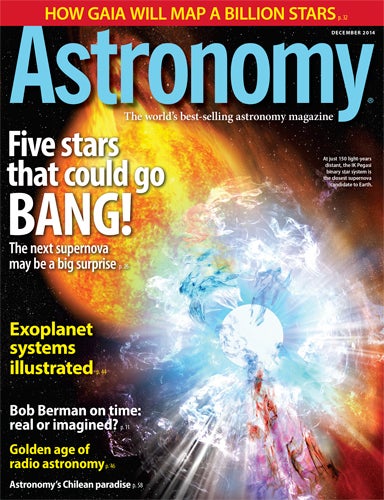
WAUKESHA, Wis. – Stellar explosions have fascinated astronomers and observers alike since ancient times. A bright point of light appears where there once was a dim speak or seemingly nothing visible at all, marking the death of star light-years away. The first recorded supernova appeared in ancient Chinese texts in A.D. 185, and astronomers now estimate that three stars explode in our galaxy every century. At the moment, though, the Milky Way appears to be falling a bit behind in the supernova statistics.
The last supernova visible to the naked eye appeared in 1680, and another would have been visible in the 1860s had dust not totally obscured its light. But that’s it for the past 400 years. So if another supernova is due, what star in our galaxy is likely to explode next?
In “Five stars that could go bang,” NASA science writer Francis Reddy explores a handful of candidates with explosive potential. None poses a significant threat to life on Earth in the immediate future, but each would put on a show no earthly observer or astronomer would want to miss. The closest aren’t the most imminently promising, but some others on the list not only are
on the cusp of exploding, but they’re also already fairly well known in our night skies. For example, how would Orion the Hunter look with a right shoulder that appeared easily in a daytime sky? Or would we have to create a new myth if a brilliant point of light appeared between Ophiuchus the Serpent-bearer and his snake?
To learn about such explosive circumstances in these two constellations as well as the other supernova candidates, pick up the December issue of Astronomy, on newsstands November 4.
“How Gaia will map a billion stars”
On December 19, 2013, the European Space Agency launched a top hat-shaped spacecraft called Gaia into orbit. It was a unique design, but what was more important was what it carried: a gigapixel camera, the largest ever launched into space. In “How Gaia will map a billion stars,” mission scientist Anthony G. A. Brown describes how astronomers will use the spacecraft’s camera and other instruments to achieve the mission’s scientific goals, including creating a 3-D map of the Milky Way based on the stellar data it has only recently begun collecting.
“The golden age of radio astronomy”
When Antony Hewish and his graduate student Jocelyn Bell first detected a strange pulsing signal in their 1967 radio data, they honestly thought it could be aliens. Follow-up studies quickly revealed something less extraterrestrial but equally interesting: the first rapidly rotating neutron star, now aptly called a pulsar. In “the golden age of radio astronomy,” learn more about this amazing discovery and other fascinating stories from radio pioneer Hewish as he recalls his days at Cambridge University studying the radio sky.
“Target winter’s best open clusters”
Most observers are familiar with this season’s starry superstars, like the Pleiades and the Double Cluster. But there are plenty other open clusters to explore on these cold nights. In “Target winter’s best open clusters,” Senior Editor Michael E. Bakich recommends 25 objects to explore, from the Pirate Moon Cluster in Taurus to Hagrid’s Dragon in Monoceros to M93 in Puppis. You’ll be seeing stars in no time.
December sky events visible without optical aid
- December 11 – Jupiter shines brilliantly near a waning gibbous Moon.
- December 14 – The Geminid meteor shower peaks.
- December 22 – The Ursid meteor shower peaks.
- December 31 – Venus and Mercury appear low in the southwestern sky after sunset.
Also in the December 2014 Astronomy
- “Exoplanet systems illustrated”: Scientists have found more than 1,800 exoplanets orbiting 1,100 stars. Here are the strangest – and the most common.
- “Chile: Visiting the astronomer’s paradise”: This tour to the Atacama Desert showcased professional observatories and the finest skies on Earth.
- “Astronomy tests Celestron’s NexStar Evolution”: This setup is as close to “grab-and-go” astronomy as an 8-inch Schmidt-Cassegrain telescope can be.
- “The Sky this Month”: Exclusive star charts will guide you through December’s night sky.
- The December issue also features Snapshot, Breakthrough, Astro News, Ask Astro, Bob Berman’s Strange Universe, Glenn Chaple’s Observing Basics, Stephen James O’Meara’s Secret Sky, Adam Block’s Cosmic Imaging, Astro Sketching, New Products, Letters, Web Talk, Reader Gallery, and Final Frontier.
Astronomy offers you the most exciting, visually stunning, thorough, and timely coverage of the heavens above. Each monthly issue includes expert science reporting, vivid color photography, complete sky-event coverage, spot-on observing tips, informative equipment reviews, and more. All of this comes in an easy-to-understand user-friendly style that’s perfect for astronomers at any level. Contact Astronomy, the world’s best-selling astronomy magazine, at 262.796.8776 or email editor@astronomy.com.









